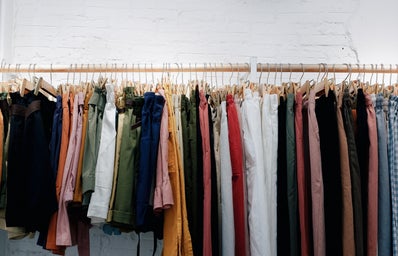Given the way every time I open TikTok there’s a new form of identity or aesthetic that’s being commodified, it’s made me question is our generation obsessed with being detached from reality? Many of us like to play ‘the main character’ but now people are personifying and morphing into new characters biweekly, ranging from the “clean girl” to currently the “mob wife”. Regardless, this phenomenon has clearly made apparent that there’s a juxtaposition between what fashion is and the way we act. With fashion being social in nature, the way somebody dresses communicates and signals things about them, thus influencing how they are perceived and labelled regardless of their intentionality to do so. Yet fashion is also an art form and it’s a way for people to express themselves. Therefore, if fashion is meant to be freeing, why is everyone suddenly the fashion police? A negative rhetoric has been built around the idea of ‘basic’ and what it means to represent it. However, who’s to say that dressing ‘basic’ isn’t a chosen form of expression; separate from the believed notion that being ‘basic’ signifies a perpetual interest in the mundane, and a lack of both autonomy and creative expression.
Anyway, let’s get into the basics of microtrends before we delve into discourse pertaining to ‘basicness’. Fashion has always functioned as something that works in conjunction with capitalism. The more we consume, the more creations get replicated and thus placed into the mainstream, forcing invention and new design concepts – with this process functioning cyclically. When pairing this with the social nature of fashion, it makes sense why and how social media is able to catalyse certain trends. This is because if a ‘new’ form of fashion expression is being communicated to people through platforms that are inherently social (meaning they promote communication and simultaneously personal expression), it makes sense how, given the global reach and mass engagement of these platforms, trends are presented and consumed in a brief time frame. Due to this, it has become evident that the gap between invention and consumption has narrowed, with the time between conceptualisation and actualisation in design and production decreasing. So much so that trends don’t sustain longevity and are no longer enjoyed, as there’s little intentionality in learning about a subculture before participating; we just jump from trend to trend.
Due to our increased consumption of short form content and thus shorter attention spans post-pandemic, we operate faster and hyper fixate on things for a shorter period than before. While in the fashion space there’s a lot of discourse about a looming fatigue with microtrends – my question is, once the rate at which they are occurring slows down what does that mean for us? It’s feasible to say that ‘micro trends’ will revert to simply being ‘trends’, meaning the cycle of conceptualisation to actualisation in design and production will increase again, but what does ‘slowness’ mean to a generation that easily gets bored? Will everyone suddenly learn to appreciate trends in the same way as before, despite our levels of sustained attention being lower, or will this fast-paced desire to consume continue?
A lot of people I see on platforms critiquing different aesthetics, trends, items, etc. embody whiteness. To me, this holds a level of irony as they perpetuate the scrutiny of ‘basicness’, when from a sociological standpoint they are representations of mainstream values and hence can be said to be basic themselves. Due to the normativity and hegemony of whiteness, they are societally accepted as the standard and ideal to be replicated. While it may sound weird to some to label whiteness as ‘mainstream’, this is only the case due to whiteness being perpetually rendered invisible. Obviously, transgressing essentialist ideas, the construction of race is fluid, meaning that race can be fashioned, worn and aestheticized – which is no stranger to the fashion industry. However, despite what people decide to cosplay as and thus signify to the world, while individuals don’t have autonomy over the race they were born as, they do with their fashion choices and material indulgences. With the influx of microtrends, all the negative discourse pertaining to ‘basicness’ highlights how there’s an increased incessant desire to look subversive and deviate from mainstream portrayals and representations in popular culture. While there shouldn’t be an overwhelming sense of negativity attached to looking like something that is over replicated and overrepresented, I understand why people want to look different and gatekeep things and I am personally an advocate of gatekeeping depending on the circumstance. As those that have a genuine interest in fashion may want a predominant distinction between their passions and what people merely view as trendy; others may just want to signal status and social superiority.
Similarly, when something is considered ‘underground’ it means it excludes the masses and, in this inaccessibility, notions of coolness are constructed simply due to it being codified as different and exclusive. Therefore, it can be said that a desired alignment with a niche fashion identity may derive from an internalised understanding of the profitability that arises from an external perception of coolness, whether it’s people getting respect from their peers, or some level of authority and or credibility within a space. Furthermore, the symbolic value of coolness enables people to create or fortify their careers, portrayed through influencer culture and the rewards they gain from the way they appear. Their appearance intertwines with perceptions of their ‘coolness’ as they gain popularity through audiences liking their personality or aspiring to replicate their dress sense. This therefore exemplifies why one would want to be linked with and subsequently embody coolness due to its tangible benefits.
Referring back to the social nature of fashion, the way that people form bonds further exemplifies how we internalise and externalise the idea of coolness. It is fair to say that most people would want to be friends with somebody they envisage themselves relating to and being comfortable around. These feelings of aligning with or gravitating towards someone are often rooted in our personal interpretations that there is something ‘cool’ about them. If this same concept is to be applied to the masses and intertwined with fashion, we can’t complain when people want to replicate what they find cool. Within social environments this is natural whether it’s deriving from a place of genuine interest, or superficiality.
It is understandable why people want to look different, especially as niche fashion expressions increasingly transform into the mainstream at a faster rate. However, people shouldn’t project their frustrations onto others when desiring to detach from these basic trends; if something is trending then it is most likely for a reason. Whether you’re a fashion avid or you enjoy what’s trending, simply express yourself and enjoy fashion for what it means to you and the way it makes you feel when you put on something you love.
Written by: Michele Ngue-Awane
Edited by: Lila Frost


